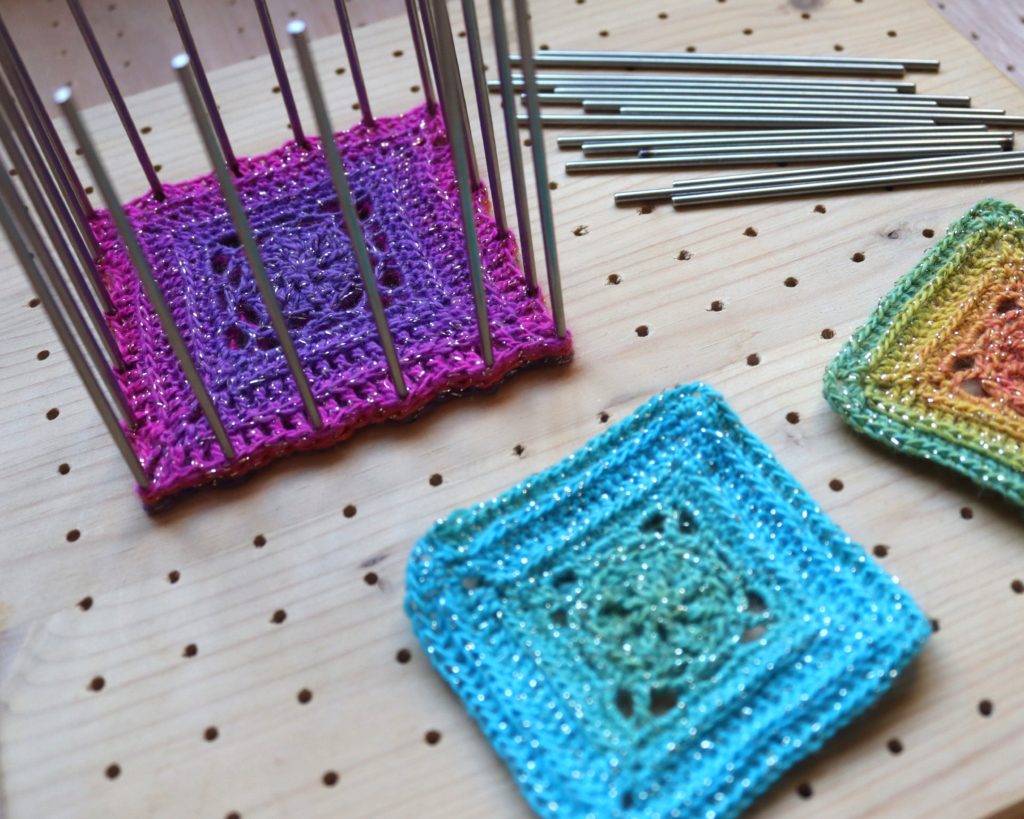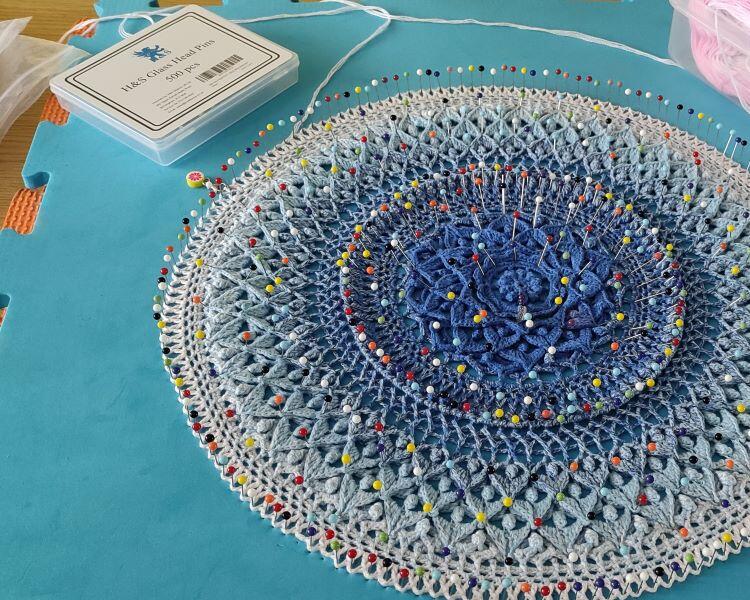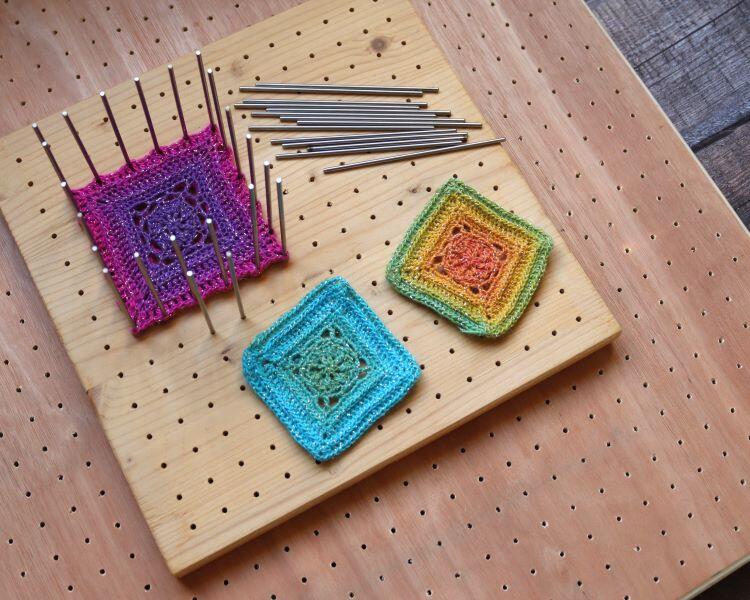Introduction
In the intricate world of crochet, every stitch counts. To ensure that your projects look their best, a crochet blocking board becomes an indispensable tool. It’s not just about making the stitches; it’s about presenting them in their best form. Whether you are a seasoned crocheter or just starting, understanding how to use a blocking board can significantly enhance the quality of your finished pieces. Blocking boards are essential tools you need for perfection of your makes: The Ultimate Guide to Crochet Tools and Accessories.

What is a Crochet Blocking Board?
A crochet blocking board is a flat surface used to shape and set your crochet projects. After you’ve completed crocheting, the fabric often needs to be stretched and shaped to achieve its final form and dimensions. This is where a blocking board comes into play. Made of various materials like foam, wood, or plastic, these boards come with grids and measurements to help align and pin your work accurately.
Why Use a Blocking Board?
Shaping is a crucial step in crochet that transforms a finished piece from a simple fabric into a work of art with defined dimensions and crisp lines. The process of shaping using a blocking board is both an art and a science. It offering the opportunity to refine and perfect the appearance of your crochet work. Here is why it is important:
- Uniformity: It ensures that all elements of your project are consistent in size and shape. For instance, in a project with multiple motifs, shaping makes sure each motif matches the others precisely.
- Fit and Size Accuracy: For wearable items like sweaters or hats, proper shaping is essential for a good fit. It helps the garment stretch to the intended size and shape.
- Aesthetic Appeal: Shaping enhances the overall look of the project, making patterns more visible and stitches more prominent and uniform.
Types of Blocking Boards
Blocking boards come in various forms. Each type has its benefits and choosing one depends on your project’s needs and your personal preferences.
Foam Boards: Lightweight and affordable, ideal for beginners.

Foam boards are a popular choice for blocking crochet projects, but like any tool, they have their advantages and drawbacks.
Pros of Foam Boards:
- Flexibility in Sizing: The interlocking nature of foam boards allows for customizable sizes, accommodating everything from small squares to large blankets.
- Lightweight and Portable: Their light construction makes them easy to move, handle, and store, a big plus for crocheters who have limited space.
- Ease of Pinning: The softness of the foam makes it easy to pin into. This is less damaging to the fibers of your crochet piece and less straining on your hands.
- Durability in Wet Conditions: Foam boards don’t warp or deteriorate when exposed to moisture, making them ideal for wet blocking.
- Affordability: Generally, foam boards are more cost-effective than other types of blocking boards, such as wooden ones.
Cons of Foam Boards:
- Durability Concerns: While foam is flexible, it can also break down or compress over time, especially under frequent use or heavy projects.
- Potential for Absorbing Odors: Foam can sometimes absorb odours, especially if it’s frequently exposed to moisture or not allowed to dry properly.
- Size Limitations: While interlocking boards can be combined to create larger surfaces, they might not be as large as some custom or pre-made wooden boards, potentially limiting the size of projects you can block on them.
- Lack of Aesthetics: Foam boards may not have the same aesthetic appeal as wooden boards. This can be a consideration for crafters who prefer a more elegant crafting setup.
- Inconsistent Grid Lines: Not all foam boards come with grid lines, and those that do might not have them as accurately printed as on more premium boards.
In summary, foam boards are a versatile and budget-friendly option for crocheters looking to shape and finish their projects through blocking. Their ease of use and adaptability to various project sizes make them a popular choice. However, considerations about their long-term durability, potential for odor absorption, and limitations in size and aesthetics are important factors to weigh when deciding if they are the right choice for your crochet needs.
Wooden Boards: Durable and sturdy, preferred by professionals.
Wooden boards are often considered a more premium option for blocking crochet projects. They offer a different set of features compared to foam boards, appealing to a range of crocheters.

Pros of Wooden Boards:
- Durability: Wooden boards are generally more durable and sturdier compared to foam boards. They can withstand frequent use and are less likely to deform over time.
- Aesthetic Appeal: Many crocheters appreciate the natural, elegant look of wooden boards. They can add a touch of sophistication to your crafting area.
- Resistance to Odors and Moisture: Wood, especially when properly treated or sealed, is less likely to absorb odours and moisture compared to foam. This makes it ideal for wet blocking.
- Stable Pinning Surface: The firmness of wood provides a stable surface for pinning. This is particularly beneficial for heavier or larger projects that require more tension.
- Long-Term Investment: While more expensive upfront, the longevity of a wooden board can make it a cost-effective choice in the long run.
Cons of Wooden Boards:
- Higher Cost: Wooden boards are typically more expensive than foam boards, which might be a barrier for beginners or those on a tight budget.
- Heavier and Less Portable: Their sturdy construction makes them heavier and less convenient to move around, store, or transport.
- Limited Size Flexibility: Unlike interlocking foam boards, wooden boards usually come in fixed sizes, which might not suit all project dimensions.
- Maintenance Requirements: Wood can require more maintenance, such as occasional sealing or treating to prevent warping or damage, especially if used frequently for wet blocking.
- Risk of Snagging: If not properly finished, wooden boards can have rough edges or splinters that might snag delicate yarns.
Wooden boards offer a robust and aesthetically pleasing option for crochet blocking, ideal for those who engage in frequent and heavy-duty blocking. Their durability and resistance to moisture make them a favourite among many crafters. However, considerations around cost, portability, size limitations, and maintenance requirements are important when determining if wooden boards align with your specific crochet needs and preferences.
Interlocking Crochet Blocking Board: Flexible in size, great for large projects.
Interlocking crochet boards have gained popularity in the crafting community due to their customizable nature and ease of use. Here’s an in-depth look at their advantages and disadvantages.
Pros of Interlocking Crochet Blocking Board:
- Customizable Size: Perhaps the biggest advantage is their modularity. You can piece together as many or as few squares as needed to accommodate projects of various sizes and shapes.
- Storage and Portability: These boards can be disassembled for compact storage, making them a space-saving option. Their lightweight nature also makes them easy to transport.
- Versatility: They are suitable for a wide range of projects, from small accessories to large garments or Afghans.
- Ease of Use: Like foam boards, interlocking boards are generally easy to pin into and are gentle on both the hands and the crochet projects.
- Affordability: They are often more budget-friendly compared to solid wooden boards, making them accessible to a wider range of crafters.
Cons of Interlocking Crochet Blocking Board:
- Durability Concerns: While convenient, these boards may not be as durable as solid wooden boards, especially under heavy use or with particularly heavy projects.
- Inconsistency in Surface Level: When piecing together multiple squares, there may be slight variations in the level of the surface, which could affect the uniformity of blocking, especially for larger projects.
- Absorption of Moisture and Odors: Like other foam products, interlocking boards can absorb moisture and odours if not properly dried or cleaned.
- Potential for Gaps: Small gaps might appear at the interlocking seams, which can be problematic for projects requiring precise pinning and tension.
- Aesthetic Considerations: While functional, interlocking boards may lack the polished look of a solid wooden board. This might be a factor for crafters who value the aesthetic aspect of their tools.
Interlocking boards offer a flexible and convenient option for crocheters looking to block projects of varying sizes and shapes. Their modularity and ease of use make them a popular choice, especially for those who need a space-saving solution. However, considerations regarding their long-term durability, potential for moisture and odour absorption, and the consistency of the blocking surface are important factors to consider when deciding if they are the right choice for your crochet blocking needs.
Tips for Using a Blocking Board
- Choose the Right Blocking Method: There are several blocking methods – wet blocking, steam blocking, and spray blocking. The choice depends on the fiber type and the project’s requirements. For example, wet blocking is generally best for natural fibers, while steam blocking can work well for synthetic fibers.
- Use the Right Tools: Apart from blocking boards, use rust-proof pins to avoid staining your work. If you’re using steam blocking, a good quality steam iron is essential. For wet blocking, towels and a basin or sink for soaking are necessary.
- Prepare Your Project Appropriately: If you’re wet blocking, soak your project in lukewarm water with a mild detergent for about 15-20 minutes. Gently squeeze out excess water without wringing, then roll in a towel to remove further moisture.
- Pin with Care and Precision: Lay your project on the blocking board and start pinning from the center moving outward. Ensure you’re following the project’s desired dimensions and shape. Use enough pins to maintain even tension but avoid overstretching.
- Utilize Blocking Wires for Straight Edges: For projects with long, straight edges (like shawls), blocking wires can be a godsend. They help create clean, straight lines and reduce the number of pins needed.
- Allow Adequate Drying Time: Patience is key in blocking. Allow your project to dry completely before unpinning. This might take 24 hours or more, depending on the material and the environment.
- Repeat if Necessary: Sometimes, especially for natural fibers, a project might need re-blocking after it’s been washed or worn.
- Be Mindful of Delicate Yarns: If working with particularly delicate or loosely spun yarns, be gentle during the soaking and pinning process to avoid damaging the fibers.
- Check the Fiber Care Instructions: Always refer to the yarn’s care label. Some fibers (like acrylic) may not respond well to certain blocking methods (like high heat).
- Measure for Consistency: This is especially important for garments or projects that require symmetry. Use a tape measure or ruler to ensure that both sides are even and to maintain the correct dimensions.
Maintaining Your Blocking Board
- Clean Regularly: Keep the board clean to ensure it doesn’t transfer dirt to your projects.
- Store Properly: Store in a flat, dry place to prevent warping or damage.
- Inspect for Damage: Regularly check for any wear and tear, especially if you use wooden or foam boards.
Conclusion
A crochet blocking board might seem like just another tool, but its impact on the quality of your crochet projects is profound. By choosing the right type of board and using it effectively, you ensure that your crochet creations are as beautiful and professional-looking as possible. Remember, the final touch to your crochet masterpiece lies in how well you block it.